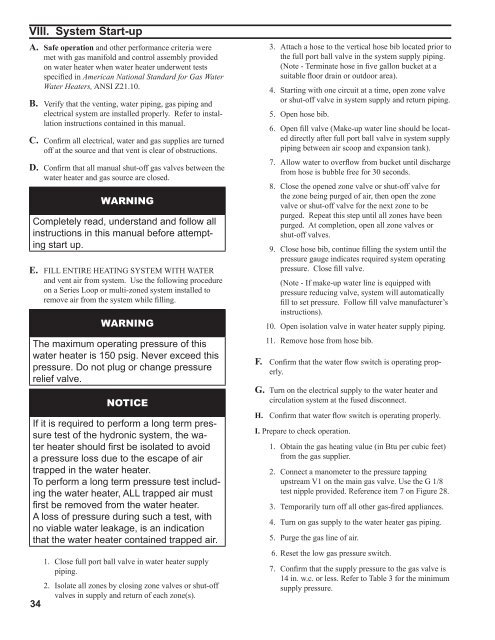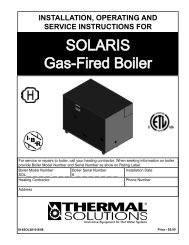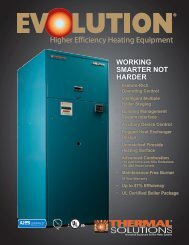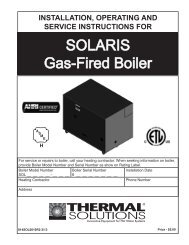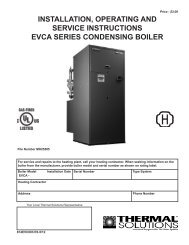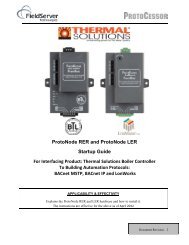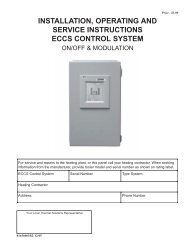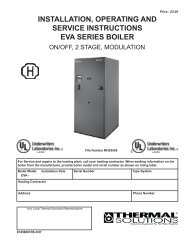I&O Manual - Solaris Water Heaters - Categories On Thermal ...
I&O Manual - Solaris Water Heaters - Categories On Thermal ...
I&O Manual - Solaris Water Heaters - Categories On Thermal ...
Create successful ePaper yourself
Turn your PDF publications into a flip-book with our unique Google optimized e-Paper software.
VIII. System Start-upA. Safe operation and other performance criteria weremet with gas manifold and control assembly providedon water heater when water heater underwent testsspecified in American National Standard for Gas <strong>Water</strong><strong>Water</strong> <strong>Heaters</strong>, ANSI Z21.10.B. Verify that the venting, water piping, gas piping andelectrical system are installed properly. Refer to installationinstructions contained in this manual.C. Confirm all electrical, water and gas supplies are turnedoff at the source and that vent is clear of obstructions.D. Confirm that all manual shut-off gas valves between thewater heater and gas source are closed.E. FILL ENTIRE HEATING SYSTEM WITH WATERand vent air from system. Use the following procedureon a Series Loop or multi-zoned system installed toremove air from the system while filling.34WARNINGCompletely read, understand and follow allinstructions in this manual before attemptingstart up.WARNINGThe maximum operating pressure of thiswater heater is 150 psig. Never exceed thispressure. Do not plug or change pressurerelief valve.NOTICEIf it is required to perform a long term pressuretest of the hydronic system, the waterheater should first be isolated to avoida pressure loss due to the escape of airtrapped in the water heater.To perform a long term pressure test includingthe water heater, ALL trapped air mustfirst be removed from the water heater.A loss of pressure during such a test, withno viable water leakage, is an indicationthat the water heater contained trapped air.1. Close full port ball valve in water heater supplypiping.2. Isolate all zones by closing zone valves or shut-offvalves in supply and return of each zone(s).3. Attach a hose to the vertical hose bib located prior tothe full port ball valve in the system supply piping.(Note - Terminate hose in five gallon bucket at asuitable floor drain or outdoor area).4. Starting with one circuit at a time, open zone valveor shut-off valve in system supply and return piping.5. Open hose bib.6. Open fill valve (Make-up water line should be locateddirectly after full port ball valve in system supplypiping between air scoop and expansion tank).7. Allow water to overflow from bucket until dischargefrom hose is bubble free for 30 seconds.8. Close the opened zone valve or shut-off valve forthe zone being purged of air, then open the zonevalve or shut-off valve for the next zone to bepurged. Repeat this step until all zones have beenpurged. At completion, open all zone valves orshut-off valves.9. Close hose bib, continue filling the system until thepressure gauge indicates required system operatingpressure. Close fill valve.(Note - If make-up water line is equipped withpressure reducing valve, system will automaticallyfill to set pressure. Follow fill valve manufacturer’sinstructions).10. Open isolation valve in water heater supply piping.11. Remove hose from hose bib.F. Confirm that the water flow switch is operating properly.G. Turn on the electrical supply to the water heater andcirculation system at the fused disconnect.H. Confirm that water flow switch is operating properly.I. Prepare to check operation.1. Obtain the gas heating value (in Btu per cubic feet)from the gas supplier.2. Connect a manometer to the pressure tappingupstream V1 on the main gas valve. Use the G 1/8test nipple provided. Reference item 7 on Figure 28.3. Temporarily turn off all other gas-fired appliances.4. Turn on gas supply to the water heater gas piping.5. Purge the gas line of air.6. Reset the low gas pressure switch.7. Confirm that the supply pressure to the gas valve is14 in. w.c. or less. Refer to Table 3 for the minimumsupply pressure.


